Cheol Jun Cho
Scaling Spoken Language Models with Syllabic Speech Tokenization
Sep 30, 2025Abstract:Spoken language models (SLMs) typically discretize speech into high-frame-rate tokens extracted from SSL speech models. As the most successful LMs are based on the Transformer architecture, processing these long token streams with self-attention is expensive, as attention scales quadratically with sequence length. A recent SSL work introduces acoustic tokenization of speech at the syllable level, which is more interpretable and potentially more scalable with significant compression in token lengths (4-5 Hz). Yet, their value for spoken language modeling is not yet fully explored. We present the first systematic study of syllabic tokenization for spoken language modeling, evaluating models on a suite of SLU benchmarks while varying training data scale. Syllabic tokens can match or surpass the previous high-frame rate tokens while significantly cutting training and inference costs, achieving more than a 2x reduction in training time and a 5x reduction in FLOPs. Our findings highlight syllable-level language modeling as a promising path to efficient long-context spoken language models.
LCS-CTC: Leveraging Soft Alignments to Enhance Phonetic Transcription Robustness
Aug 05, 2025Abstract:Phonetic speech transcription is crucial for fine-grained linguistic analysis and downstream speech applications. While Connectionist Temporal Classification (CTC) is a widely used approach for such tasks due to its efficiency, it often falls short in recognition performance, especially under unclear and nonfluent speech. In this work, we propose LCS-CTC, a two-stage framework for phoneme-level speech recognition that combines a similarity-aware local alignment algorithm with a constrained CTC training objective. By predicting fine-grained frame-phoneme cost matrices and applying a modified Longest Common Subsequence (LCS) algorithm, our method identifies high-confidence alignment zones which are used to constrain the CTC decoding path space, thereby reducing overfitting and improving generalization ability, which enables both robust recognition and text-free forced alignment. Experiments on both LibriSpeech and PPA demonstrate that LCS-CTC consistently outperforms vanilla CTC baselines, suggesting its potential to unify phoneme modeling across fluent and non-fluent speech.
Analyzing The Language of Visual Tokens
Nov 07, 2024



Abstract:With the introduction of transformer-based models for vision and language tasks, such as LLaVA and Chameleon, there has been renewed interest in the discrete tokenized representation of images. These models often treat image patches as discrete tokens, analogous to words in natural language, learning joint alignments between visual and human languages. However, little is known about the statistical behavior of these visual languages - whether they follow similar frequency distributions, grammatical structures, or topologies as natural languages. In this paper, we take a natural-language-centric approach to analyzing discrete visual languages and uncover striking similarities and fundamental differences. We demonstrate that, although visual languages adhere to Zipfian distributions, higher token innovation drives greater entropy and lower compression, with tokens predominantly representing object parts, indicating intermediate granularity. We also show that visual languages lack cohesive grammatical structures, leading to higher perplexity and weaker hierarchical organization compared to natural languages. Finally, we demonstrate that, while vision models align more closely with natural languages than other models, this alignment remains significantly weaker than the cohesion found within natural languages. Through these experiments, we demonstrate how understanding the statistical properties of discrete visual languages can inform the design of more effective computer vision models.
Sylber: Syllabic Embedding Representation of Speech from Raw Audio
Oct 09, 2024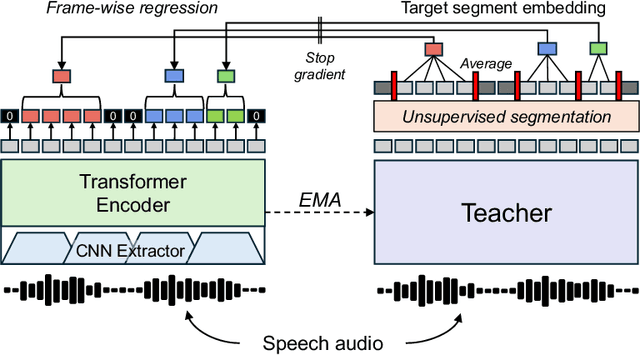

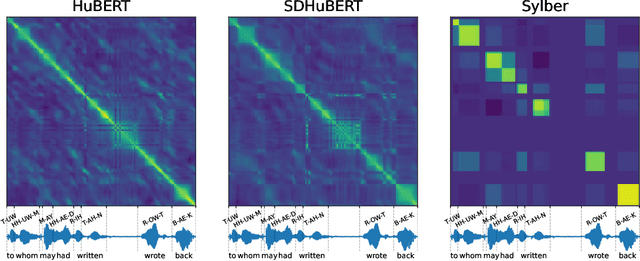
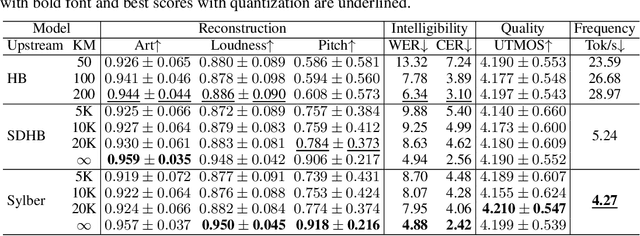
Abstract:Syllables are compositional units of spoken language that play a crucial role in human speech perception and production. However, current neural speech representations lack structure, resulting in dense token sequences that are costly to process. To bridge this gap, we propose a new model, Sylber, that produces speech representations with clean and robust syllabic structure. Specifically, we propose a self-supervised model that regresses features on syllabic segments distilled from a teacher model which is an exponential moving average of the model in training. This results in a highly structured representation of speech features, offering three key benefits: 1) a fast, linear-time syllable segmentation algorithm, 2) efficient syllabic tokenization with an average of 4.27 tokens per second, and 3) syllabic units better suited for lexical and syntactic understanding. We also train token-to-speech generative models with our syllabic units and show that fully intelligible speech can be reconstructed from these tokens. Lastly, we observe that categorical perception, a linguistic phenomenon of speech perception, emerges naturally in our model, making the embedding space more categorical and sparse than previous self-supervised learning approaches. Together, we present a novel self-supervised approach for representing speech as syllables, with significant potential for efficient speech tokenization and spoken language modeling.
Stutter-Solver: End-to-end Multi-lingual Dysfluency Detection
Sep 15, 2024Abstract:Current de-facto dysfluency modeling methods utilize template matching algorithms which are not generalizable to out-of-domain real-world dysfluencies across languages, and are not scalable with increasing amounts of training data. To handle these problems, we propose Stutter-Solver: an end-to-end framework that detects dysfluency with accurate type and time transcription, inspired by the YOLO object detection algorithm. Stutter-Solver can handle co-dysfluencies and is a natural multi-lingual dysfluency detector. To leverage scalability and boost performance, we also introduce three novel dysfluency corpora: VCTK-Pro, VCTK-Art, and AISHELL3-Pro, simulating natural spoken dysfluencies including repetition, block, missing, replacement, and prolongation through articulatory-encodec and TTS-based methods. Our approach achieves state-of-the-art performance on all available dysfluency corpora. Code and datasets are open-sourced at https://github.com/eureka235/Stutter-Solver
Fast, High-Quality and Parameter-Efficient Articulatory Synthesis using Differentiable DSP
Sep 04, 2024



Abstract:Articulatory trajectories like electromagnetic articulography (EMA) provide a low-dimensional representation of the vocal tract filter and have been used as natural, grounded features for speech synthesis. Differentiable digital signal processing (DDSP) is a parameter-efficient framework for audio synthesis. Therefore, integrating low-dimensional EMA features with DDSP can significantly enhance the computational efficiency of speech synthesis. In this paper, we propose a fast, high-quality, and parameter-efficient DDSP articulatory vocoder that can synthesize speech from EMA, F0, and loudness. We incorporate several techniques to solve the harmonics / noise imbalance problem, and add a multi-resolution adversarial loss for better synthesis quality. Our model achieves a transcription word error rate (WER) of 6.67% and a mean opinion score (MOS) of 3.74, with an improvement of 1.63% and 0.16 compared to the state-of-the-art (SOTA) baseline. Our DDSP vocoder is 4.9x faster than the baseline on CPU during inference, and can generate speech of comparable quality with only 0.4M parameters, in contrast to the 9M parameters required by the SOTA.
Articulatory Encodec: Vocal Tract Kinematics as a Codec for Speech
Jun 18, 2024
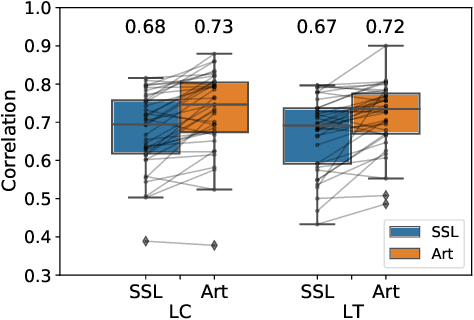
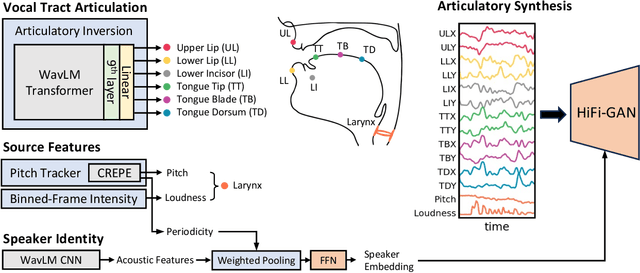
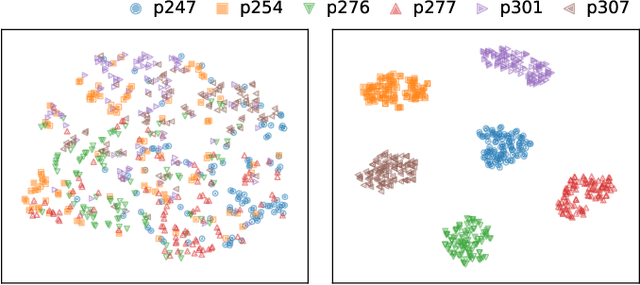
Abstract:Vocal tract articulation is a natural, grounded control space of speech production. The spatiotemporal coordination of articulators combined with the vocal source shapes intelligible speech sounds to enable effective spoken communication. Based on this physiological grounding of speech, we propose a new framework of neural encoding-decoding of speech -- articulatory encodec. The articulatory encodec comprises an articulatory analysis model that infers articulatory features from speech audio, and an articulatory synthesis model that synthesizes speech audio from articulatory features. The articulatory features are kinematic traces of vocal tract articulators and source features, which are intuitively interpretable and controllable, being the actual physical interface of speech production. An additional speaker identity encoder is jointly trained with the articulatory synthesizer to inform the voice texture of individual speakers. By training on large-scale speech data, we achieve a fully intelligible, high-quality articulatory synthesizer that generalizes to unseen speakers. Furthermore, the speaker embedding is effectively disentangled from articulations, which enables accent-perserving zero-shot voice conversion. To the best of our knowledge, this is the first demonstration of universal, high-performance articulatory inference and synthesis, suggesting the proposed framework as a powerful coding system of speech.
Unconstrained Dysfluency Modeling for Dysfluent Speech Transcription and Detection
Dec 20, 2023Abstract:Dysfluent speech modeling requires time-accurate and silence-aware transcription at both the word-level and phonetic-level. However, current research in dysfluency modeling primarily focuses on either transcription or detection, and the performance of each aspect remains limited. In this work, we present an unconstrained dysfluency modeling (UDM) approach that addresses both transcription and detection in an automatic and hierarchical manner. UDM eliminates the need for extensive manual annotation by providing a comprehensive solution. Furthermore, we introduce a simulated dysfluent dataset called VCTK++ to enhance the capabilities of UDM in phonetic transcription. Our experimental results demonstrate the effectiveness and robustness of our proposed methods in both transcription and detection tasks.
SD-HuBERT: Self-Distillation Induces Syllabic Organization in HuBERT
Oct 16, 2023



Abstract:Data-driven unit discovery in self-supervised learning (SSL) of speech has embarked on a new era of spoken language processing. Yet, the discovered units often remain in phonetic space, limiting the utility of SSL representations. Here, we demonstrate that a syllabic organization emerges in learning sentence-level representation of speech. In particular, we adopt "self-distillation" objective to fine-tune the pretrained HuBERT with an aggregator token that summarizes the entire sentence. Without any supervision, the resulting model draws definite boundaries in speech, and the representations across frames show salient syllabic structures. We demonstrate that this emergent structure largely corresponds to the ground truth syllables. Furthermore, we propose a new benchmark task, Spoken Speech ABX, for evaluating sentence-level representation of speech. When compared to previous models, our model outperforms in both unsupervised syllable discovery and learning sentence-level representation. Together, we demonstrate that the self-distillation of HuBERT gives rise to syllabic organization without relying on external labels or modalities, and potentially provides novel data-driven units for spoken language modeling.
Self-Supervised Models of Speech Infer Universal Articulatory Kinematics
Oct 16, 2023



Abstract:Self-Supervised Learning (SSL) based models of speech have shown remarkable performance on a range of downstream tasks. These state-of-the-art models have remained blackboxes, but many recent studies have begun "probing" models like HuBERT, to correlate their internal representations to different aspects of speech. In this paper, we show "inference of articulatory kinematics" as fundamental property of SSL models, i.e., the ability of these models to transform acoustics into the causal articulatory dynamics underlying the speech signal. We also show that this abstraction is largely overlapping across the language of the data used to train the model, with preference to the language with similar phonological system. Furthermore, we show that with simple affine transformations, Acoustic-to-Articulatory inversion (AAI) is transferrable across speakers, even across genders, languages, and dialects, showing the generalizability of this property. Together, these results shed new light on the internals of SSL models that are critical to their superior performance, and open up new avenues into language-agnostic universal models for speech engineering, that are interpretable and grounded in speech science.
 Add to Chrome
Add to Chrome Add to Firefox
Add to Firefox Add to Edge
Add to Edge